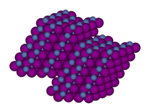Search results
Appearance
There is a page named "Dimethoxyethane" on Wikipedia
- Dimethoxyethane, also known as glyme, monoglyme, dimethyl glycol, ethylene glycol dimethyl ether, dimethyl cellosolve, and DME, is a colorless, aprotic...6 KB (358 words) - 23:19, 3 February 2025
- Illustrative unsymmetrical ethers are anisole (methoxybenzene) and dimethoxyethane. Vinyl- and acetylenic ethers are far less common than alkyl or aryl...19 KB (1,843 words) - 18:54, 16 December 2024
- 4-dioxane, tetrahydrofuran, sulfolane, acetaldehyde, dimethylformamide, dimethoxyethane, dimethyl sulfoxide, acetonitrile. Partially miscible with diethyl...172 KB (20,541 words) - 15:44, 14 March 2025
- dimethoxyethane solution of NbCl5 with 1,4-disilyl-cyclohexadiene in the presence of 3-hexyne produces the coordination complex NbCl3(dimethoxyethane)(3-hexyne):...6 KB (504 words) - 09:24, 3 January 2024
- presence of water scavengers, hydrated nickel(II) chloride reacts with dimethoxyethane (dme) to form the molecular complex NiCl2(dme)2. The dme ligands in...15 KB (1,289 words) - 11:47, 24 December 2024
- may refer to: Any of the glycol ethers, a class of solvents, usually dimethoxyethane if not otherwise specified River Glyme, a river in Oxfordshire, England...200 bytes (57 words) - 15:14, 28 December 2019
- Na2[Fe(CO)4]. It is always used as a solvate, e.g., with tetrahydrofuran or dimethoxyethane, which bind to the sodium cation. An oxygen-sensitive colourless solid...8 KB (667 words) - 20:11, 12 December 2024
- (THF); the half-life in THF solutions is about 40 minutes at −20 °C. In dimethoxyethane, the half-life is about 11 minutes at −70 °C In this example, the reaction...11 KB (1,009 words) - 16:47, 7 March 2025
- down into smaller or monomeric units in the presence of solvents like dimethoxyethane (DME) or ligands like tetramethylethylenediamine (TMEDA). As an exception...144 KB (14,076 words) - 18:55, 30 March 2025
- tetrahydrofuran (THF), 2-methyltetrahydrofuran (2-MeTHF), dioxane, and 1,2-dimethoxyethane (DME). The synthesis of this compound can be done in two different...11 KB (1,093 words) - 09:01, 22 October 2024
- lithium batteries, usually together with a low-viscosity solvent (e.g. dimethoxyethane). Its high polarity allows it to create an effective solvation shell...8 KB (739 words) - 00:42, 13 March 2025
- used as an emulsifier in cosmetics Ethylene glycol dimethyl ether (dimethoxyethane, monoglyme, CH3OCH2CH2OCH3), a higher boiling alternative to diethyl...8 KB (699 words) - 18:46, 20 March 2025
- 3-Butanediol 1,4-Butanediol 2,3-Butanediol tert-Butyl hydroperoxide Dimethoxyethane 2-Ethoxyethanol 1-Methoxy-2-propanol Diethyl peroxide This set index...420 bytes (63 words) - 08:35, 13 March 2022
- diethanolamine 111-42-2 HN(CH2CH2NH2)2 diethylenetriamine 111-40-0 C4H10O2 dimethoxyethane 110-71-4 (CH3)2NC(O)H dimethylformamide 68-12-2 C2H8N2 1,1-dimethylhydrazine...4 KB (36 words) - 16:45, 31 March 2024
- Tetrakis(ethanol) and 1,2-Dimethoxyethane Complexes". Anhydrous Nickel (II) Halides and their Tetrakis(Ethanol) and 1,2-Dimethoxyethane Complexes. Inorganic...5 KB (386 words) - 09:23, 19 March 2025
- alcohols in the presence of primary alcohols using NBS in aqueous dimethoxyethane (DME). NBS electrophilically brominates the amine, which is followed...14 KB (1,190 words) - 20:12, 30 January 2025
- 0.814 1-Octanol 0.826 p-Xylene 0.861 m-Xylene 0.864 Toluene 0.867 Dimethoxyethane 0.868 Benzene 0.879 Butyl acetate 0.882 1-Chlorobutane 0.886 Tetrahydrofuran...47 KB (3,837 words) - 20:32, 12 February 2025
- fourth one is stereoselective: The gauche effect is also seen in 1,2-dimethoxyethane[citation needed] and some vicinal-dinitroalkyl compounds. The alkene...7 KB (869 words) - 09:55, 15 March 2025
- Tetrahydrofuran THF 0.56, 0.547 Dimethylformamide DMF 0.45, 0.470 Acetone (CH3)2C=O 0.48 Dimethylsulfoxide DMSO 0.435 Dimethoxyethane DME 0.51, 0.580...11 KB (1,276 words) - 10:23, 1 May 2024
- (psychedelic), 3,4-dimethoxy-beta-hydroxyphenethylamine, a psychedelic drug Dimethoxyethane, a solvent Dimethylethanolamine, a precursor molecule for C-choline...1 KB (154 words) - 17:12, 26 December 2023
- English Wikipedia has an article on: dimethoxyethane Wikipedia dimethoxyethane (uncountable) (organic chemistry) The dimethyl ether of ethylene glycol;
- Effectiveness for this is in the order diethyl ether < THF < 1,2-dimethoxyethane < HMPA. In principle any unsaturated molecule can form a radical anion














